Happy New-ish Year!
Both photos above are from last week. See the three on the French round table? They were repotted just before Thanksgiving, and are doing great. All have fresh growth, a good sign that everyone is happy, as well as plenty of moss plus weeds. For now the weeds can stay because I welcome the extra pop of greenery during these gray wintry days. When they start to overwhelm, time to yank them out to conserve nutrients for the myrtles. The velvety moss stays; its roots are not as deep or invasive.
For scale, here I am 😊 next to one of my giant triples. Now twice their original size, this handsome pair came from the nursery of the late Allen C. Haskell, a fine horticulturalist and nurseryman with a passion for topiaries.
In DC, dwarf myrtle cannot live outside during winter. It must come in before any threat of a freeze, which is around early October. Once inside, avoid placing near a radiator or heat register. After all danger of a frost is over, it can go back outside for sunshine and fresh air. Keep protected from thunderstorms, heavy rain and strong winds as this top-heavy plant can easily fall over.
SUNLIGHT
Give it as much light as possible, especially indoors. Otherwise it will turn spindly and not have that coveted density. Make sure to rotate occasionally for even growth on all sides.
WATERING
Never let the myrtle dry out completely, but water accordingly. If sitting outside in full sun, especially in a porous clay pot, daily watering might be necessary. Be mindful not to have water sitting in the saucer for too long as this can cause root rot. During winter I generally water (use lukewarm, please) every other day; do so until water seeps out in the saucer, which should be reabsorbed within 3 – 5 hours. Dump out any excess water afterwards. Misting is also beneficial.
REPOTTING
Usually the topiary is already in a pot that is too small, making it somewhat root bound – that’s ok for a while. Think of it as a bonsai where you want to focus its energy / growth on top rather than at the roots. However, when it absorbs water too fast and needs constant watering, time to repot. Choose a pot one size larger to keep the proportions balanced. Also, if a pot is overly spacious the plant will waste energy sending out excessive roots.
CLIPPING
To maintain a neat, tight form, clipping or shearing should be done every two weeks from late winter to the end of summer. Monthly is recommended for the rest of the year. This also encourages denser growth because whenever a shoot / sprig is clipped, two new ones emerge to create more foliage. When not in a rush, I clip at the branch between the leaves, being careful not to cut the actual foliage which can create unsightly brown spots. But since I have so many, I tend to just shear the entire “ball.”
FERTILIZING
From late winter to early fall, I will fertilize with Miracle-Gro once a month. Fertilizing is essential to the success of container gardening where the nutrients are depleted by the plant as well as leached out with watering.
INSECTS
Bugs are unavoidable. I spray liberally with a mild insecticidal soap on the foliage and soil. If persistent, take to your nursery for diagnosis and proper treatment.
SHEDDING
Shedding of the old leaves as new ones form is to be expected. But excessive dropping may be due to diseases, insects, changes in light and moisture levels, etc. Please consult your nursery’s specialist.
And that’s all! Just minutes each day dedicated to the care of a few living sculptures that add such warmth, charm and personality. I really love these civilized yet whimsical beauties, and couldn’t imagine not having them.
In our former home, myrtles lived amongst us in nearly every room. Enjoy these photos – many taken by photographer Helen Norman for Martha Stewart Living and Southern Living magazines.
Here I am demonstrating how to properly clip using my favorite Japanese pruners. If any seem tipsy, steady their trunks while clipping.
Additionally, I have other types of topiaries like this pair of rosemary. Unfortunately both were zapped by the frost when left outside during an unusually frigid winter.
Why are we moving? We found another small home (a Cotswold style Tudor) on a large lot with plenty of gardening potential 🌼. More to come!
Cheers,
Loi

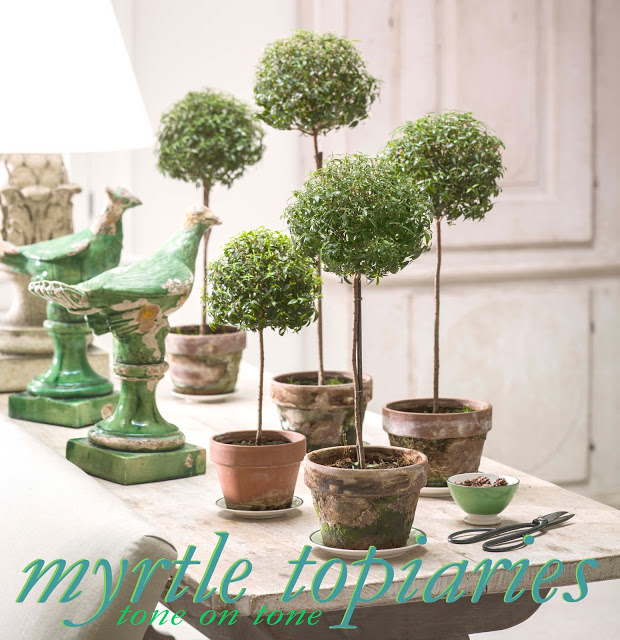
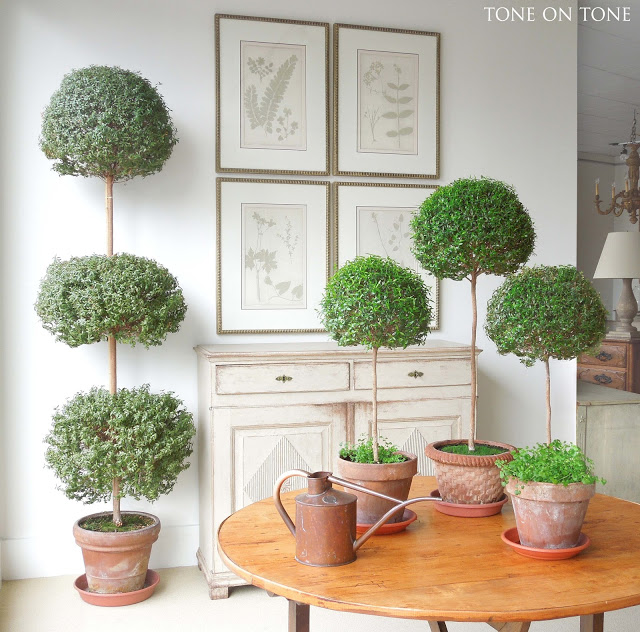
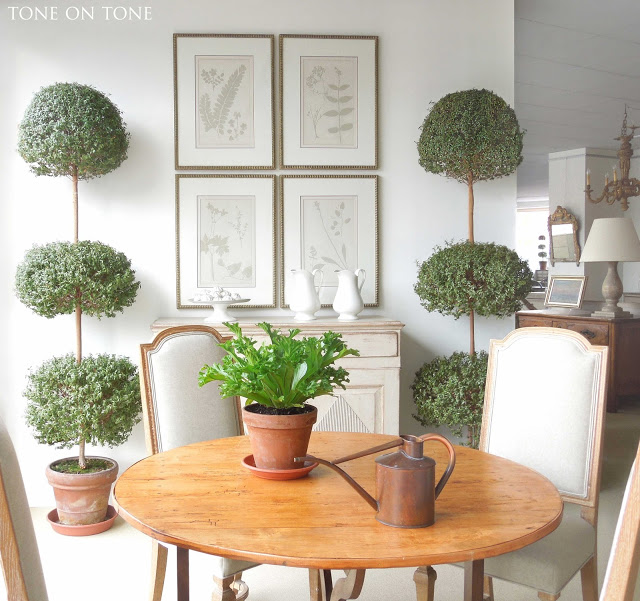

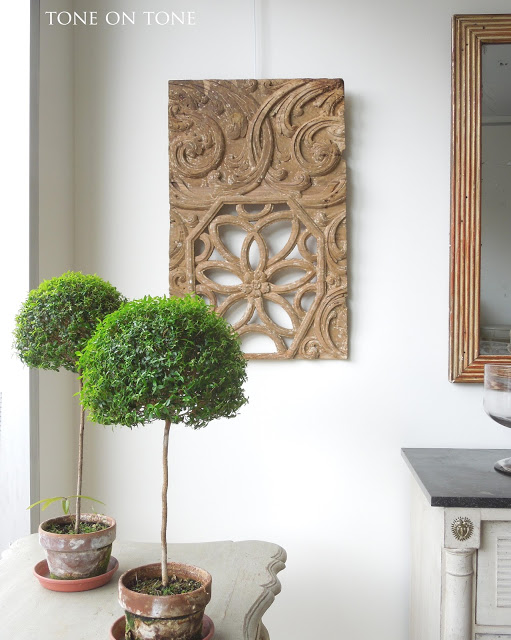
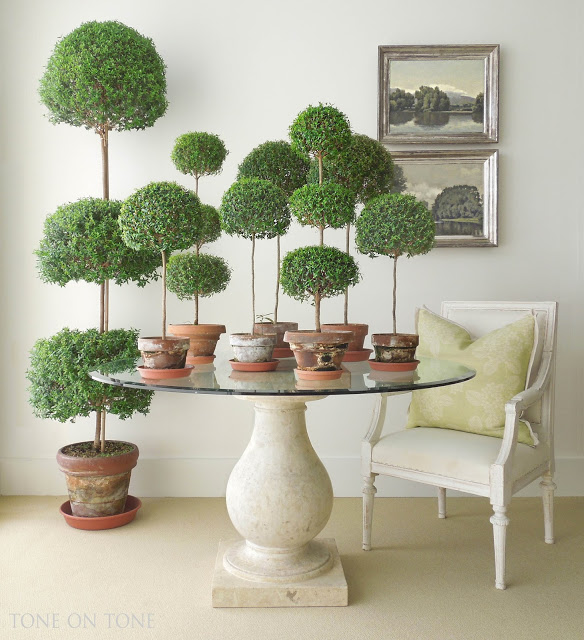
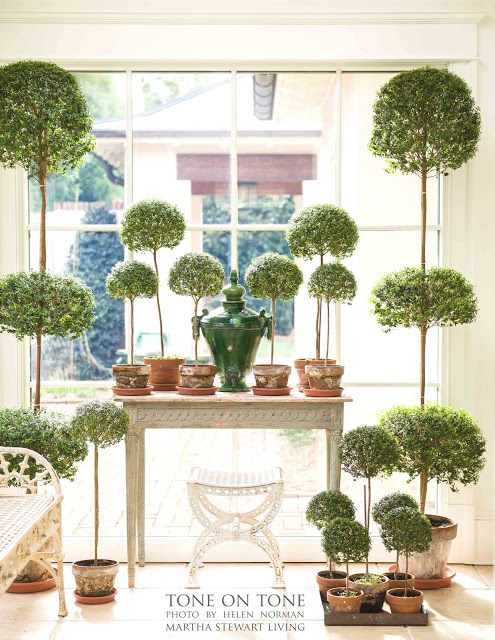


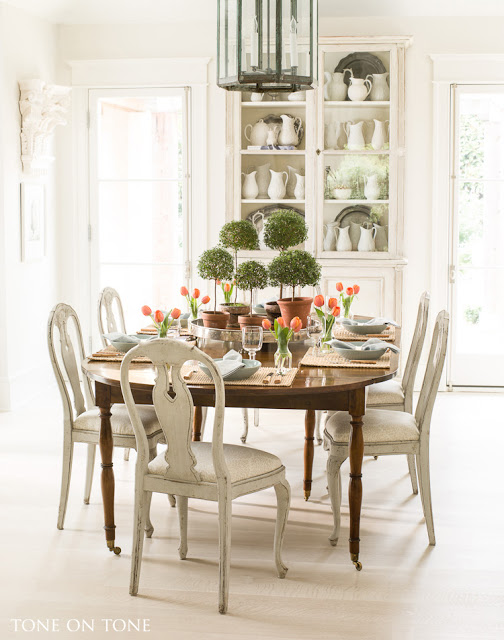
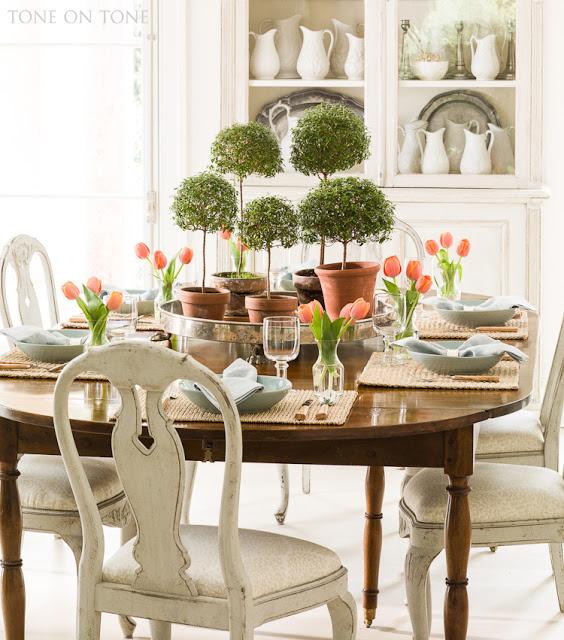
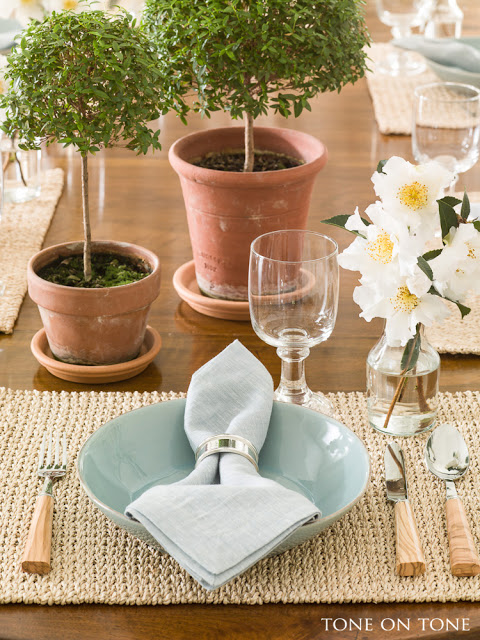
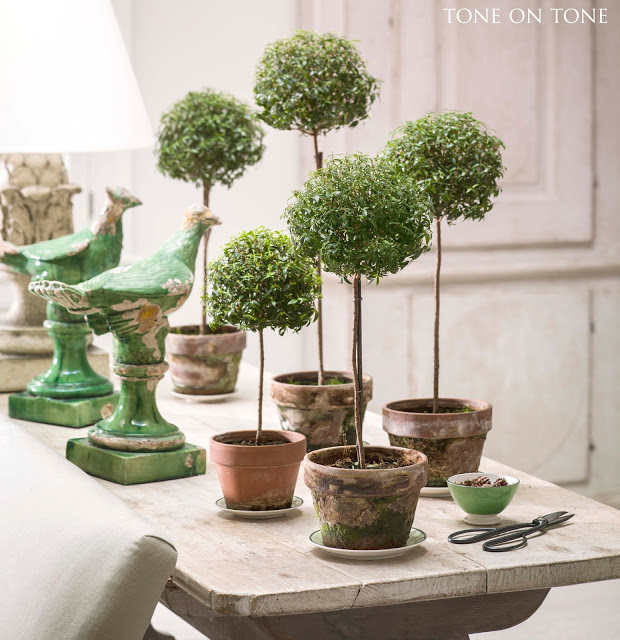
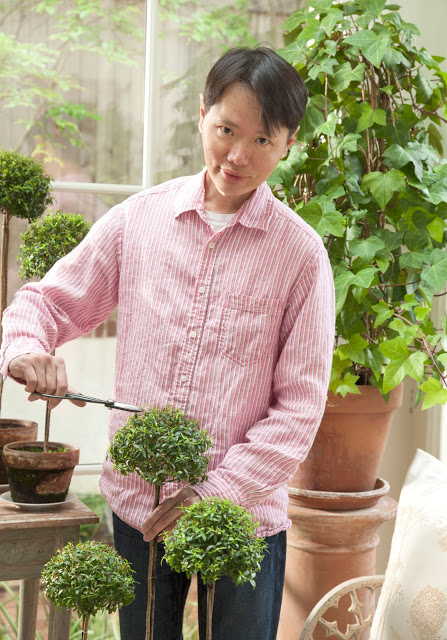

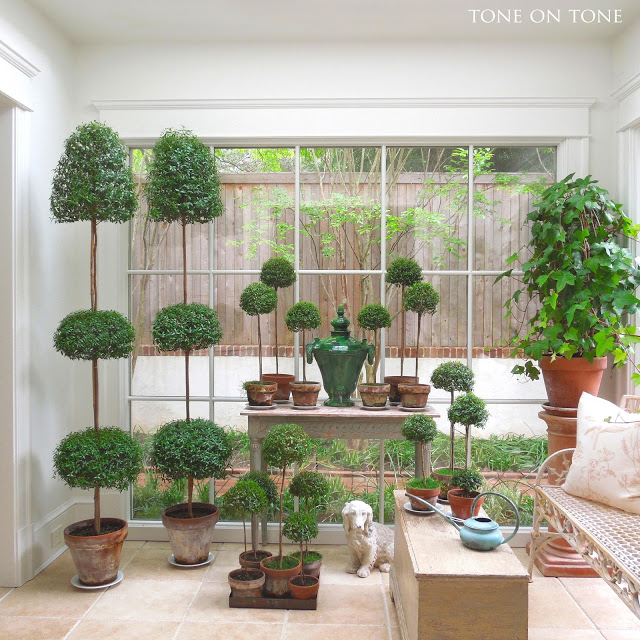
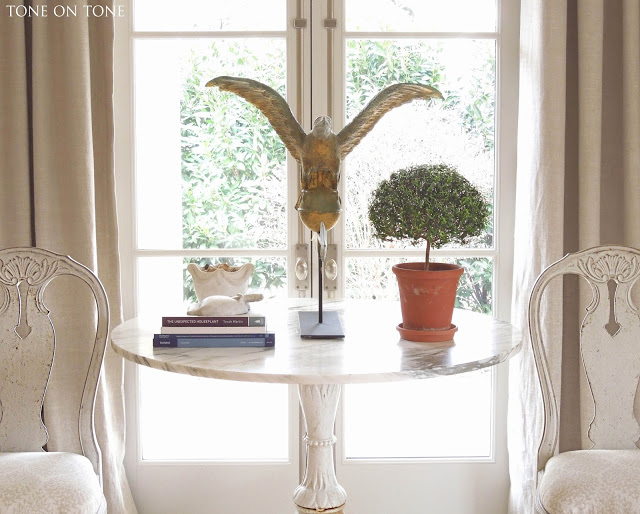



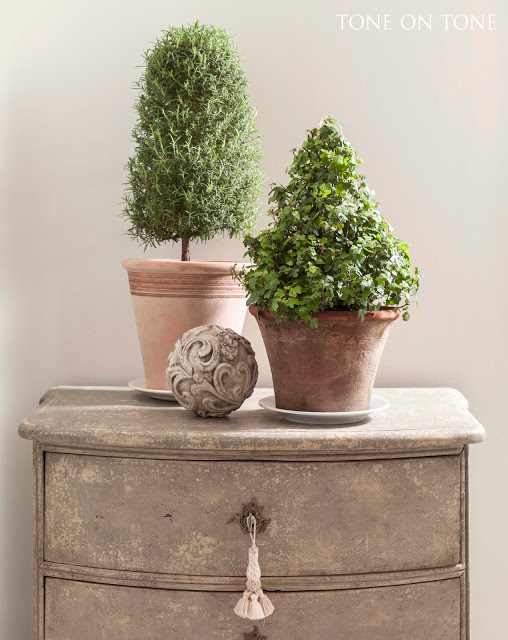
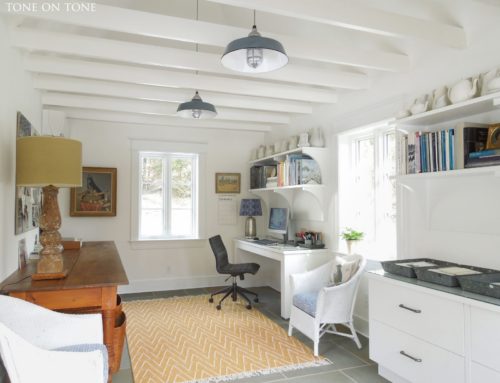
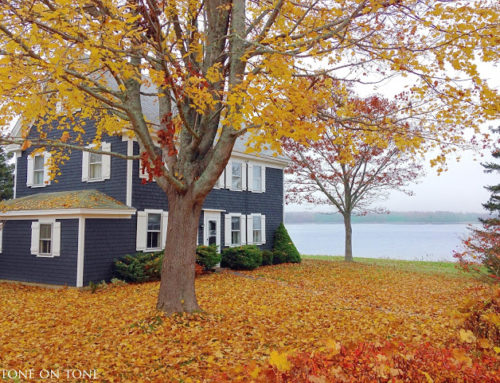
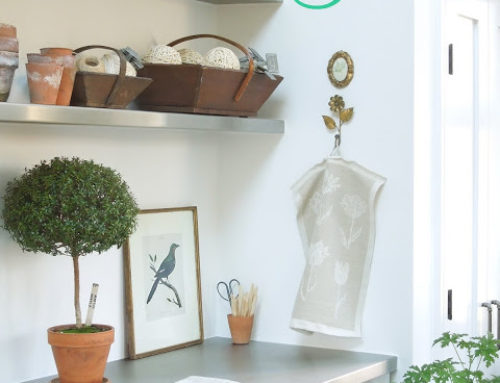
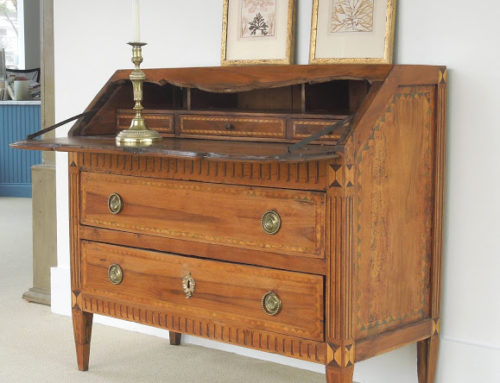

Oh my, these are gorgeous. Thanks for the tips. I just love your photos.
Thanks for visiting, Ron. Cheers
Absolutely beautiful! You are the master of topiaries! Some green inside makes a huge difference, I can't do without even though it is challenging sometimes! How exciting you are moving to a bigger lot. Cant wait to see what you will so with it!
Hi Inga – Lovely to hear from you! I miss your blog so much. Hope you're well. Take care
Hello Loi, I didn't know that you had so many topiaries–usually we just see a few at a time. You claim that it is easy, but we can see the careful effort that goes into them, as in all your projects.
–Jim
I have way toooooo many 🙂 Finding happy spots for them during winter can be challenging. Thanks for visiting, Jim.
Oh my goodness Loi – they are just SO beautiful! You really need to do a YouTube tutorial – we need to see that fancy clip work in action! Best of luck with the move my friend – I admire your ability to beautify and move on – I tend to be constantly looking for the next possible move, but the idea of actually acting on it, and the upheaval it would cause makes me chicken out and hide under the bedclothes! xxx
I hope this will be our last move 🙂 We've renovated six houses in the last 20 years! Time for a break. Thanks, Paula. xo
Happy New Year! Your topiaries are beautiful! They add so much sculptural dignity to a room. I think I'll have to get a pair this Spring.
Thanks so much, Linda. Give it a try and share with us on your blog.
I am saving this post for future reference so I can properly care for my "Myrtle" She is special!….You definitely have a green thumb and the "ladies" love you so much! OK..moving again?..you must have found a fabulous place!!!
Yup….moving, again!! This is house number 6. And hopefully the last one, haha. Thanks, Shirley.
What a beautiful post… a visual delight. Thanks so much. It made my day!
Lisa-Charlottesville, VA
Hi, Lisa! Glad you enjoyed this post. Always a pleasure to hear from you.
I'm sure you will make your new home beautiful! Thank you for your beautiful post on topiaries, I didn't realize it was such an art. Thanks you for also sharing some of your home. I just love your beautiful aesthetic, so peaceful and calming.
Thanks so much for visiting, Sarah. Lovely to have you. Cheers
Dear Loi, your topiaries are so beautiful. Thank you for your wonderful post! My husband and I are actually looking for a house to buy and we are interested in your Tudor that you mentioned might be on the market soon. The pictures that you have posted of your Tudor in this post and older posts are beautiful and marvelous. Thank you so much.
Hi Ali – Thanks so much! If you email me at topiaryplants@gmail.com I'll share the listing with you once it's ready. Cheers
i would love to be able to care for these lovely topiaries as you do. so peaceful and lovely. and i'm glad you are moving again because it makes me feel better about all my moving! we don't plan to sell the illinois house yet but i do like to move. the arizona one is kind of an experiment to see whether we will use it enough (translation: will we make more time for vacation?) to hang on to it. gorgeous pics here that are inspiring me to post more swedish themed stories on HELLO LOVELY! best to you as you transition and feather your new nest. xox
Michele, hopefully this one is the last! I love your new home! And so fun following your adventures on Instagram. xo
These are truly extraordinary – you have a green thumb! I was especially struck by the small pots that your giant topiaries live in. Quite amazing. I wish I had your talent (and your antiques, and your home, and…. 😉 !)
Thanks so much, Jean, for your visit and sweet words! Made my day 🙂 xoxo
LOI! How beautiful is your world, no matter where you dwell. The light from your shoppe window is the perfect backdrop to highlight such marvelous antiques and plants. The greens must love this space! And I look forward to seeing your new tudor!Please blog on that!
Hi friend! You and I share a passion for Tudors. I love the ones you share on Instagram – enchanting cottages!!
What a happy post Loi! Those topiaries are so healthy and green and they create just the right accent for your beautiful collection of furniture, art ,antiques etc. The information you provided has inspired me to try my luck.
Another home and the opportunity to tastefully transform what has to be an already aesthetically pleasing place because you have great taste and vision! Cannot wait to hear more about it – an idea for another post!
Thank YOU so much!! I look forward to sharing our new home soon. Enjoy the weekend ahead.
YOU have LANDED in my INBOX after a couple of YEARS of NOT ARRIVING!!!!!!!
MIRACLES NEVER CEASE!
BEAUTIFUL TOPIARIES………..
LOVE THE BIG ONES!
Thank you, Contessa! I'm thrilled to have you back 🙂 xoxo
Hi Loi,
I've always loved your myrtle topiaries. I appreciate the detailed care instructions. I have ivy and rosemary topiaries that are pretty easy but have yet to adventure into the world of myrtles. Maybe 2017 will be the year!
xo,
Karen
Hope you'll give myrtles a try, Karen. And let me know how you do. Thanks, friend.
Hi, Loi. Happy new year! Your plants are gorgeous, as are your photos. Nice to see you back in blogville. I hope you had a wonderful holiday.
Claudia
Great to be back! Thanks, Claudia. Cheers
I always love seeing your topiaries and just fascinated that you can keep them looking so beautiful. My black thumb would be buying new ones on a monthly basis. Adore your beautiful home!
Thank you so much, Kristy 🙂 Hugs to you and Beth!!
Loi, I'm crushing over your topiaries. They are exquisite! I hope to get some Myrtle topiaries and try my hand at this. I've got a sunporch that gets morning sun that just might be a perfect spot. At least that it what I'm hoping. I'm printing off your instructions. Thank you!
That sounds like the perfect spot, Sarah. Good luck, my friend. xo
Thank you Loi for this fabulous post. After a long day in Real Estate & Design this post welcomed me home and settled me right down with that warm feeling that all is well with the world (and me). I am very interested in your new home as we just got back at the end of the year from the Cotswolds (Chipping Campden) our 7th trip there…is it Cotswold stone? Or is it English Tudor…is it like William Morris' Kelmscott ( which I love)…can't wait to see it and what you will do with it. I have not had time to comment recently but I have been following reading, scanning and dreaming. Thank you for sharing your wonderful life!
Hi Maggie – Thanks for asking about our new home. It's a stucco cottage with stone and brick. The roof has charming scalloped slate tiles. I'll share soon. Cheers
Such energy you'al have!! Topiaries are friends. franki
I know, right?? This is hopefully our last home 😉
I love your topiaries! Can you please post about how you keep them so nicely shaped and, especially, how you keep the pairs so symmetrical? I am someone who can barely draw a circle – I wouldn't trust myself to cut spheres 🙂
Lots of practice!! Yes, I'm thinking of doing a quick video of me trimming one 🙂
Loi–this is so beautiful, and perfectly reflects your graceful lifestyle. I still ache to come visit you and see your lovely shop . . . Someday . . . When the newest family member is a bit bigger, I think! Congratulations on the house–I'm hoping you've found "the one" and have many happy years making it your own! Hugs–Amanda
Amanda!! Love hearing from you. And seeing pics of your beautiful baby – what a joy!! Give Andrew a big hug.
How gorgeous! You know we were one of the people stalking your Instagram page and reposting your pretty pictures. We're so envious of your green thumb as ours are black… You truly are the topiary tamer!
xxoo
C + C
Thank you, ladies! Always a pleasure to hear from y'all. xoxo
They are such pretty little sculptures!
They really are like sculptures! Thanks, Miranda.
You are a wealth of knowledge! Thank you for that tutorial. I feel like I might be able to do this. As for topics I'd like to see you blog about, I love your neutral interiors and especially how you add color to them. I'd love to hear how you decide where and how much color to add. Do you like to add color using art? With pillows and throws? It looks so effortless when you do it. I also love your garden posts, and look forward to what you will do in your new yard.
Hi Amy – Many thanks for your questions. Please stay tuned because I'll answer them in an upcoming post. xoxo
I am so envious! I LOVE topiaries. We had a dozen boxwood topiaries that got wiped out in a week from a bug; the boxwoods at the neighboring chateau also were ravaged, so if they couldn't keep up I doubt I could have done better. Also a rose topiary that has gotten more and more deformed over the years. You have me wanting to try again, because they are the quintessential French garden element.
I'm so sorry to hear about your boxwood! We have the blight here, and it has wiped out many box. Merci beaucoup!
Hi Loi, Lovely post today! The topiaries are just gorgeous, so elegant. All the best on your next move, can't wait to see all that you'll do!
I've not seen this award yet! It's super and I love the concept! paleoreviewworld
You had me at "gardening potential." I can't wait to see it!
Stay tuned on Instagram, my friend. Will post exterior pics soon. xo
It is amazing how perfect you make them!! What a beautiful accessory they make! I love all your posts!! xo
Thanks so much, Leslie. Cheers, my friend!
Incredible post regarding the topiaries….I second that request for the You Tube video showing you actually trimming. You are INCREDIBLE!!! Cannot wait to see your new home and the magic you work there. It will be delightful. I am staying tuned, as always!
Awwww, thanks Vickie 🙂 Appreciate you visiting AND your kind words!!
Once again your topiaries amaze me, and I so wish I had the space to fill with this much potted Beaty in my small cottage.
Breathtaking my dear.
Xx
Dore
Thank you, Dore! I always enjoy hearing from you. xoxo
Loi this was such an informative post. I am not a very good indoor gardener but I am trying to be better. The question is where can we find myrtle topiaries? I can't wait to see what you do with your new home!
Cindy, since the myrtles are top heavy and fragile, it's a challenge to find a source that ships. I don't know of a source near you. Good luck!
A few years ago, your blog inspired me to give myrtle topiaries a try after my ivy ones would always develop a bug problem. The myrtle topiaries are beautiful and pretty easy to care for. In the summer I keep them on my covered front porch and for the rest of the year they reside in my kitchen window. Thanks for the inspiration.
Dear Anonymous – Thrilled to know that you've become a myrtle fan 🙂 Thank YOU for leaving a message. I love hearing from readers. BTW, I started with a pair, and now my collection is around 40 or so. Way too many, haha
Another advantage is that my cats don't bother them. They usually attack other indoor plants and fresh cut flowers.
Loi thank you for such valuable information and so much eye candy too! Love seeing all of your beautiful topiaries and YOU, too!! I am going to check to see if they can be grown outside here in California. I need to have topiaries for each side of our garage door.
Thank you for your words of wisdom here, I LOVE myrtle and i have two that look a bit weak right now so I will follow your advice and hopefully bring them back to life!!
Your post was so informative and has inspired me to go on a hunt to find some so that I may grow my own! They are so beautiful. I have quite the brown thumb when it comes to indoor plants, so hopefully they can survive with me as their plant master! I will have to go on the hunt for them this weekend!
I just love myrtle…great advices too!
Have a lovely sunday!
Titti
SO happy I did not miss this..as you are my myrtle hero!!!! I have four that I have had for almost a year and this is big news for me lol. I am going to give them a haircut today as I don;t think I am trimming them often enough…this was super informative and I am going to have to share this post with my readers as you are most definitely the myrtle guru!! Hope you are well……
Hi Loi,
Just beautiful!! I love Myrtle!! I am having a very hard time finding them in my area. I live in Northern CA. Do you have any advice for me? I would be happy if they had to be shipped. Many Thanks!!! Stacey Costello
Loi, I wish I had just a fraction of your green thumb! I love myrtle topiary but generally don't have good luck with them. I have one that I have managed to keep alive since Labor Day but I'm not seeing any new growth – does new growth occur throughout the year or only seasonally? xoxo
PS – Very exciting about your new place! Hope to see photos soon!
Hello, thank you very much for the content, it contains several special tips.
Did I miss a post on your tudor house renovation? I would love to see all that you have done to it.
I look forward to your posts- please don't stop blogging!
Loi- how stunning these are!! I don't blame you for taking them with you during travels…I would too! I'm wondering if you might share which are your favorite trimmers, and which type of insecticidal soap you find the best for this type of plant care?
I'm going to try my hand at growing one even though I'm the one in the family without the green thumb 😉
Website Design in AtlantaWebsite Development Websites Optimized for desktop, tablet and phone Products and Services Clearly Defined Search Engine Optimized Blog Setup. And more 404-664-5310
Website Design in AtlantaWebsite Development Websites Optimized for desktop, tablet and phone Products and Services Clearly Defined Search Engine Optimized Blog Setup. And more 404-664-5310
The blog was absolutely fantastic! Lot of great information which can be helpful in some or the other way. We are an innovative web design company in Austin offering the widest range of website development, search engine optimization & internet marketing services.
web design austin
web developer austin
شركة مكافحة بق الفراش بالدمام
هل تود الاستعانة بأفضل شركات عزل الاسطح بالدمام مع الحصول علي اكبر فترة ضمان عليك بشركة النسور تقدم الشركة عروض وخصومات رائعة فقط عليك بزيارة موقعنا
شركة عزل اسطح بالدمام
I am going on vacation for 9 days and wanted to know what yo do so she does not dry out for this time. How to keep her watered.
Hi, great to find this blog! I've had my myrtle topiary for just over 5 years and it's been doing quite well. It's not as dense as I would like it – I didn't prune it very often at the beginning and the second summer it caught some insects and I had to trim it all the way down, but since then it's grown back and I've been able to keep it in a relatively nice shape. But a consistent problem – and why it's not very dense in the middle – has been that the leaves in the middle of the plant keep drying out and falling off – everything else on the outside are great. What am I doing wrong? I water and mist it very consistently, usually misting it once a day in the summer, every couple or 3 days starting in the fall, but the leaves in the middle keep dropping. Any advice would be much appreciated!
I should add that my plant has always been indoors, by a west-facing window. I'm in Toronto, Canada, which is pretty dry in the winter. I also cover the pot with peat moss (which I mist consistently) to keep the soil moist at all times. Thanks again!
I have the same problem. I live in Vancouver and keep my plant indoors, watering it consistently every couple of days. The soil is moist, the leaves of the outside are perfect, but the ones in the middle keep drying and falling off. Did you find a solution to this? Would love to know!
Loi, your talent is awe-inspiring. Thank you for taking the time to share the details of this process and couple it with the most magnificent, gorgeous, incrdieble photos. Gah! I'm swooning over here!
This article is very detailed and informative on this topic, thanks for sharing! seo service in gurgaon
What a wonderful way to unite gardens by working together to offer these great giveaways. bestreviewsation
I appreciate your post and it was superb .Thanks for sharing.I would like to hear more about this in future..Again thanks for sharing. Visit My blog post:-transcendreviewzone
I have read this blog post. Very informative blog site. Stumped about proper tree care? Rely on the professional arborists of Alpha Arbor Ltd. in High Wycombe and nearby areas. Our services include tree care, pruning, trimming, felling, site clearance and removal. Contact us today for an estimate.
tree care Amersham
tree care Chalfont St Giles
tree care Beaconsfield
tree care High Wycombe
tree care Watford
So I have a myrtle topiary and it started getting this white fluffy stuff on the branches and I have no clue how to fix it. Any ideas? I’ve had it for a year now.
I have read this blog post. Excellent blog. Thank you for sharing. Keep it up.
site clearance High Wycombe
This is a very informative blog. Thank you for sharing. Keep it up.
tree care Amersham
tree care Chalfont St Giles
tree care Beaconsfield
tree care High Wycombe
tree care Watford
Wow…. I love, love, love your topiaries. They are so beautiful. So jealous with envy since I’m just a newbie at gardening.. I did plant some rosemary and a fig tree and they survived. Yaaaaaay! You don’t understand, I’ve had more casualties than successes. My father had a green thumb, he could grow anything, anywhere and tried to teach me his secrets. But he passed at 93 before I could learn his gardening secrets. But no worries, I’m determined to make him proud or die trying, LOL
What do you recommend for a newbie? I live in South Carolina. We moved from Boyds, Maryland after 21 years and I too have a huge back and side yard with a creek in the back.
Any advise is greatly appreciated.
How do you keep your moss alive.? I’d love to plant moss on my soil but given the myrtles need sun all day and moss likes shade…..
[…] Greenhouses. They stock myrtle, westringia and geranium topiaries. And then also be sure to read this great article on how to keep them alive […]